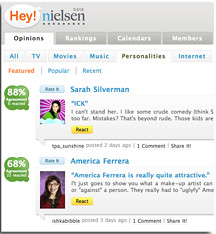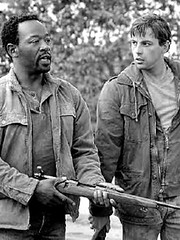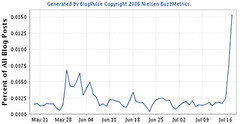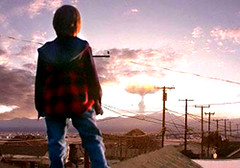Social media and social networks aren't likely to die to this year or ever. But there is much more than headline grabs associated with the growing number of articles that claim this or that is losing its luster or that what seems to be a decade old career is already on the chopping block. This story has history.
Radio, television, and web marketing all enjoyed honeymoon periods too as early adopters rode the wave of specialty into the mainstream. All three witnessed a short-term, one generation boom in agencies that specialized in radio advertising, television campaigns, and websites. And all three eventually saw a crash in specialization as marketing and advertising firms absorbed them.
Social media is being absorbed by marketers, communicators, and public relations professionals as a skill set rather than a career. And while it's likely some specialization will survive with increasingly generic titles for categorization purposes at bigger shops and departments (e.g., digital content), smaller shops will merely delegate the duties out to whomever seems suited to do it — to the delight of public relations professionals (perhaps) and chagrin of copywriters (perhaps). Of course, the medium will mostly survive even if the marketing designations do not. Social is not shiny anymore.
Does social media just barely deliver more benefits than consequences?
But then again, it doesn't make any sense to bemoan how marketers see social media. It's the public that counts in this space, not always the ones who are paid to provide content. So what do they think?
According to the newest poll by Harris, participants are seeing more tangible benefits from social media than they had five years ago. In fact, the finding almost comes across as celebratory overall.
• 50 percent of U.S. adults have received a good suggestion to try something (up from 40%).
• 21 percent of Americans cited receiving a job opportunity though social media (up from 15%).
• 11 percent of those surveyed found a new apartment or house using social media (up from 9%).
Not surprisingly, Harris reports that Millennials are more likely than other generations to benefit. The comparative numbers are compelling. There seems to be an advantage for so-called digital natives.
• 66 percent of Millennials received a good suggestion (vs. 56% Xers, 37% Boomers, 33% Matures).
• 37 percent made a job opportunity connection (vs. 24% Xers, 10% Boomers, 6% Matures).
• 19 percent found a new apartment or home (vs. 11% Xers, 5% Boomers, 2% Matures).
At a glance, it almost sounds like a triumph until you dig deeper into the numbers. While the benefits of social media are improving, the negative experiences are growing right along with them. Look out.
• 51 percent of social media participants have been offended by content (up from 43%).
• 8 percent also say they have gotten into trouble with school or work because of online content.
• 7 percent have lost a potential job opportunity because of pictures or posts they've made online.
And much like Millennials and Generation Xers are more likely to receive benefits, they are more likely to feel some heartache too. Millennials are almost twice as likely to see offensive content than Matures. It's not necessarily just because they have thin skins. The potential correlated to usage.
Along with being offended, bullied, or generally made unhappy by the experience (regardless of platform), privacy confidence is slipping. Fewer people believe that privacy settings will protect them from potentially bad experiences. Some professionals will be surprised (maybe) that 71 percent still cling to this notion, which is down 8 percent.
When you summarize the positive and negative experiences among most participants, the general consensus seems to be that people have a 50-50 benefit-consequence ratio, which is probably one of the lowest benefit-consequence ratios among experiences that people seek out. Generally, consumers would avoid benefit-consequence this low unless the experience is considered mandatory.
Interestingly enough, most strategic communicators have their focus on enhancing customer experience touch points. And in some cases, a few of these senior professionals are looking for touch points by bypassing volatile platforms where consumers are already being influenced by negativity.
That doesn't necessarily mean they intend to abandon social media, but it does provide some insight into why some marketers are looking forward to enchanted objects where they can manage more of the customer experience and provide them outposts away from more lower benefit-consequence experiences. It makes some sense, with the takeaway being that social media is likely due for an overhaul in how it works for organization-customer experiences. What do you think?
Radio, television, and web marketing all enjoyed honeymoon periods too as early adopters rode the wave of specialty into the mainstream. All three witnessed a short-term, one generation boom in agencies that specialized in radio advertising, television campaigns, and websites. And all three eventually saw a crash in specialization as marketing and advertising firms absorbed them.
Social media is being absorbed by marketers, communicators, and public relations professionals as a skill set rather than a career. And while it's likely some specialization will survive with increasingly generic titles for categorization purposes at bigger shops and departments (e.g., digital content), smaller shops will merely delegate the duties out to whomever seems suited to do it — to the delight of public relations professionals (perhaps) and chagrin of copywriters (perhaps). Of course, the medium will mostly survive even if the marketing designations do not. Social is not shiny anymore.
Does social media just barely deliver more benefits than consequences?
But then again, it doesn't make any sense to bemoan how marketers see social media. It's the public that counts in this space, not always the ones who are paid to provide content. So what do they think?
According to the newest poll by Harris, participants are seeing more tangible benefits from social media than they had five years ago. In fact, the finding almost comes across as celebratory overall.
• 50 percent of U.S. adults have received a good suggestion to try something (up from 40%).
• 21 percent of Americans cited receiving a job opportunity though social media (up from 15%).
• 11 percent of those surveyed found a new apartment or house using social media (up from 9%).
Not surprisingly, Harris reports that Millennials are more likely than other generations to benefit. The comparative numbers are compelling. There seems to be an advantage for so-called digital natives.
• 66 percent of Millennials received a good suggestion (vs. 56% Xers, 37% Boomers, 33% Matures).
• 37 percent made a job opportunity connection (vs. 24% Xers, 10% Boomers, 6% Matures).
• 19 percent found a new apartment or home (vs. 11% Xers, 5% Boomers, 2% Matures).
At a glance, it almost sounds like a triumph until you dig deeper into the numbers. While the benefits of social media are improving, the negative experiences are growing right along with them. Look out.
• 51 percent of social media participants have been offended by content (up from 43%).
• 8 percent also say they have gotten into trouble with school or work because of online content.
• 7 percent have lost a potential job opportunity because of pictures or posts they've made online.
And much like Millennials and Generation Xers are more likely to receive benefits, they are more likely to feel some heartache too. Millennials are almost twice as likely to see offensive content than Matures. It's not necessarily just because they have thin skins. The potential correlated to usage.
Along with being offended, bullied, or generally made unhappy by the experience (regardless of platform), privacy confidence is slipping. Fewer people believe that privacy settings will protect them from potentially bad experiences. Some professionals will be surprised (maybe) that 71 percent still cling to this notion, which is down 8 percent.
When you summarize the positive and negative experiences among most participants, the general consensus seems to be that people have a 50-50 benefit-consequence ratio, which is probably one of the lowest benefit-consequence ratios among experiences that people seek out. Generally, consumers would avoid benefit-consequence this low unless the experience is considered mandatory.
Interestingly enough, most strategic communicators have their focus on enhancing customer experience touch points. And in some cases, a few of these senior professionals are looking for touch points by bypassing volatile platforms where consumers are already being influenced by negativity.
That doesn't necessarily mean they intend to abandon social media, but it does provide some insight into why some marketers are looking forward to enchanted objects where they can manage more of the customer experience and provide them outposts away from more lower benefit-consequence experiences. It makes some sense, with the takeaway being that social media is likely due for an overhaul in how it works for organization-customer experiences. What do you think?


































